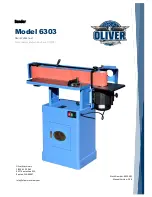
16
E
17
E
Accessories
• 2 x 80 Grit sanding belt
(1 fitted to tool and 1 spare)
• Sanding frame
• Spare drive belt
• Dust canister set
• Vacuum adaptor
Unpacking
Due to modern mass production techniques,
it is unlikely that your RONA power tool is
faulty or that a part is missing. If you find
anything wrong, do not operate the tool until
the parts have been replaced or the fault has
been rectified. Failure to do so could result in
serious personal injury.
Switching on and off
1. Pull the on/off trigger (5) upward to start the
sander (fig. A).
2. By pulling the switch on and pressing the
lock-on button (4), you can lock the sander
on (fig. B).
3. Pulling the switch on again and releasing it
turns the sander off.
Adjusting the speed
The speed can be
adjusted to suit the
material being sanded.
1. To adjust the speed,
move the variable
speed control (13)
until you reach the
optimum speed for
the job (fig. C).
Attaching a sanding belt
CAUTION:
Switch off the sander and
disconnect it from the power point.
1. Turn the belt tension
lever (7) to release
the tension on the
belt and slide off the
old belt (fig. D).
2. Check that the
replacement belt
has a good join
and is not frayed at
the edges.
3. Slip the new belt into position with the
rotation arrow on the inside of the belt
pointing in the same direction as the arrow
on the sander (fig. E).
4. Turn the belt tension lever (7) anti-clockwise
to re-tension the belt (fig. F).
5. Plug the sander into
a power point and
with the sander held
tight, pull the on/off
trigger switch (5)
and allow the belt
to rotate for a short
period (fig. G).
6. While the belt is
running, adjust the
tracking knob (10) to
align the belt to the
centre of the roller
(6). Repeat the trigger
action and tracking
adjustment until
the belt is correctly
aligned. Run the sander for a minute or so
to ensure correct alignment before using the
sander on a workpiece (fig. H).
WARNING:
Do not continue to use the
sander with a sanding belt that is overworn or
damaged.
WARNING:
Do not use the same sanding
belt for wood and metal. Metal particles
become embedded in the belt and will scour
a wooden surface.
Selecting the right grade of
sanding belt
Different grades of sanding belt can be
purchased from your local RONA store.
Typical grades are Coarse (40 grit), Medium
(80 and 100 grit) and Fine (120 grit).
Use Coarse grade to remove rough finishes,
Medium grade to smooth the work and Fine
grade to finish it off. It is best to make a trial
run on a scrap piece of material to determine
the optimum grades of belt for a particular job.
In order to take full advantage of your sander,
always purchase good quality belts.
Note.
After sanding with a belt sander, an
orbital sander should be used to give a better
surface finish.
Sanding
1. The sander is designed for sanding wood,
metal, plastic and similar materials. It is
used mainly for quickly removing a large
amount of material. Do not use this sander
for sanding magnesium.
2. Ensure that the belt is in good condition.
3. Plug in the tool to the power socket.
4. Bring down the sander onto the work piece
and apply light pressure (fig. I).
5. Pull up the trigger switch (5) and allow the
belt to reach full speed before moving it
across the work (fig. J).
6. Press the lock-on button (4) if you require
continuous operation.
7. Sand with the grain, in parallel overlapping
strokes.
8. To remove paint or smooth out very rough
wood, sand across the grain at 45˚ in two
directions, and then finish parallel with
the grain.
9. Use the front roller
(8) only to sand
corners or irregular
shapes (fig. K).
10. Lift the sander off
the work before
switching off.
11. Remember to keep
your hands away
from the moving belt, as it will continue to
move for a short time after the machine is
switched off.
12. Wear safety goggles, a dust mask
and earmuffs.
OPERATING INSTRUCTIONS
OPERATING INSTRUCTIONS
A
B
C
D
F
E
G
H
I
J
K




























